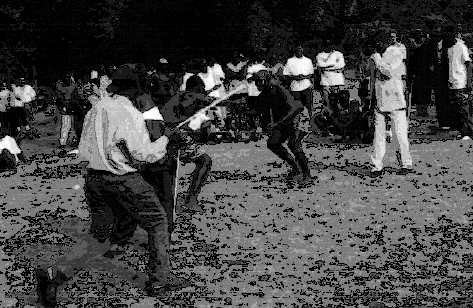Mohammed Hussen Tino
On 4 August 2001, Nuba Mountain Solidarity Abroad in Holland organised an importance cultural day in the capital, Den Haag. This was the first Nuba cultural event in Europe. Many Nuba residing in various parts of Europe were able to come and some came from Kenya to take part in this event. It was an exciting day full of many activities aimed to show not only the Dutch but also the European people our vibrant Nuba culture.
 The day started with an excellent exhibition displayed around the hall demonstrating the distinctive culture of the Nuba people. Striking images by famous photographers were displayed along with fine examples of Nuba artefacts demonstrating the unique talents and skill of Nuba artisans. Beautifully decorated hand made cups, drawings and lovely pictures reflected the natural beauty of the Nuba Mountains. In addition, there were some agricultural crops that are found only in the Nuba Mountains. Books and newsletters about the Nuba were shown. The Nuba special dish made from sorghum which is known as "Aseida" was prepared and served by the Nuba women at lunch time. All these showed the richness of Nuba culture and their old civilisation which goes back to the Kush Kingdom of the 8th Century.
The day started with an excellent exhibition displayed around the hall demonstrating the distinctive culture of the Nuba people. Striking images by famous photographers were displayed along with fine examples of Nuba artefacts demonstrating the unique talents and skill of Nuba artisans. Beautifully decorated hand made cups, drawings and lovely pictures reflected the natural beauty of the Nuba Mountains. In addition, there were some agricultural crops that are found only in the Nuba Mountains. Books and newsletters about the Nuba were shown. The Nuba special dish made from sorghum which is known as "Aseida" was prepared and served by the Nuba women at lunch time. All these showed the richness of Nuba culture and their old civilisation which goes back to the Kush Kingdom of the 8th Century.
There were speeches and explanations by Nuba intellectuals and their friends at the Novib organisation who kindly sponsored this event. They spoke about the diversity of Nuba culture and how important this
is to them. For example: the Sibir, which is a spiritual occasion, is practised extensively in the whole region of the Nuba Mountains and there are more than 20 types of Sibir in the area. The most important one is ‘the Cultivation Sibir’ which usually takes place at the end of the harvest season. One of the speakers spoke about the role of women in Nuba society and that how women work side by side with men, in various fields such as building houses, on the farm and even on the battlefield when it is required to so.
In the afternoon all the people moved from the hall to the nearby public park where a spectacular display of Nuba dancing, music and sport took place. The sound of African drums and music rose into the air inviting people in the park to join in. Many outsiders joined in, giving a tangible expression of solidarity which added to the joy of the occasion.
The afternoon event started with the ‘Krang’ which originates from the Dilling area but nowadays is
played in all parts of the Mountains. The Tera dance was next, performed by a group of dancers whose exquisite movements shook their entire bodies. Then came Kambala, the famous spiritual dance performed by people from Kadugli. It is now one of the main national dances in the Sudan. May people took part in the dance and the dancers, with buffalo horns over their heads and rattles tied to their legs performed spectacularly. I believe many of the audience had never seen anything live like this.
The event was then concluded by the most important sport in the Nuba Mountains, wrestling, which many of our guests had come especially to see. The bouts were particularly spectacular as the wrestlers had decorated their bodies with paint in the same way as wrestlers do back at home in the Nuba Mountains.
bodies with paint in the same way as wrestlers do back at home in the Nuba Mountains.
I am sure many people had enjoyed this cultural day from the beginning to the end. One Dutch man cam up to me and said " I have never seen something like even on TV. You have very rich culture and you should do not let this important culture of yours to be destroyed".
In conclusion, it was a successful day as the Nuba were able to demonstrate to the European people their distinctive culture which they are fighting to maintain in Sudan. It is hoped that such an event can be repeated every year in various parts of Europe as well as in other parts of the world to enlighten people about the Nuba’s vibrant culture and their unique civilisation.